"Every great craft brew begins with the hops."
–Anonymous (Well, tbh, we just made it up;
but it must be “true” in some way, right?)
HOPS FARMING aNd Agriculture
Hops farming requires a minimum of 120 days for a growing season. The images depict the harvest season from the initial preparing of the land to freshly harvested brewing hops. Hops provide the bitterness, aromas, and flavour for home brew.
You can learn about hops agriculture and the particular varieties of brewing hops we farm on this page. A concise overview of growing hops can be read here. An overview of Hops agriculture and production in the US can be seen here.

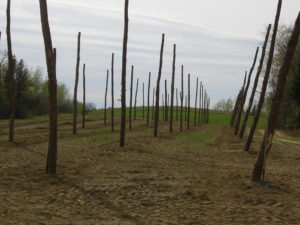


Hops Farming at Bloomfield Hops
Bloomfield Hops Farm
Bloomfield Hops Farm was started with three acres for growing hops plants in 2016 by owner, Murray Metcalfe. The farm is located off highway 550 in western New Brunswick, Canada, just over an hour’s drive from Fredericton, which is the capitol city for a province with less than one million. The US border with Maine is only a few miles west.
The quality of our hops has helped us become the exclusive supplier of Cascade hops to Picaroons Brewing in Fredericton, NB.
This region of both Canada and the US is devoted primarily to farming and has experienced little industrialization in the past. Environmental conditions for growing season is excellent.
Hops Farming - Agriculture
Hops (Humulus lupulus) plants are perenniels that flourish in regions from 35-55 degrees lattitude north. They are hardy enough to withstand a chilly winter season as long as the growing season lasts at least 120 days. The growing season here is from early-May until late-September, depending on each season.
A deep, sandy. loam soil that drains well is ideal for hops farming. A ph count of 6 to 7 for the soil is most desired for brew hops to thrive. The topography and soil along the Saint John River Valley has been ideal farming land for centuries. Our location in the valley of the second largest river in Atlantic Canada provides warmer temperatures in the summer that are ideal for hops to grow. There is significant research about growing hops in the US, which supplies over 40% of world consumption.
Humulus lupulus Agriculture
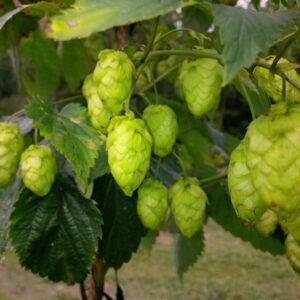
Planting HOps

Hops Farming - Planting
The average temperature in July and August in our region is just under 20 degrees celcius and hovers over 15 and 16 in June and Septemper. Our rainfall and warm sunny days make it an ideal climate for hops farming.
Hops (or Humulus lupulus) plants should be planted to absorb the full sun of the day in the northern regions. At Bloomfield Hops Farm we use wooden poles and wires to provide a support system for the hops to grow.
Hops Farming - Harvesting
The plants attain a height of 20 feet or more. Each Humulus lupulus will produce anywhere from 1/2 a pound of hops (Golding) to over 1.3 pounds (Chinook). We now have hops planted over 6 acres with 8 different varieties: Cascade, Chinook, Centenniel, Golding, Willamette, Saaz, Fuggel and Tettnang.
Our present varieties and planting strategy is to provide premium quality hops that can offer the widest possible range of craft brewing experiences.
Harvesting Bloomfield Hops
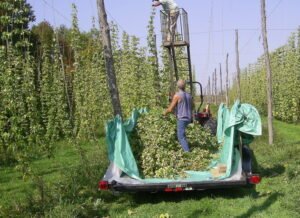
Website Construction Special! Hop to it!
25% off your first Order of Hops Products or Buy 2 Get 1 free!
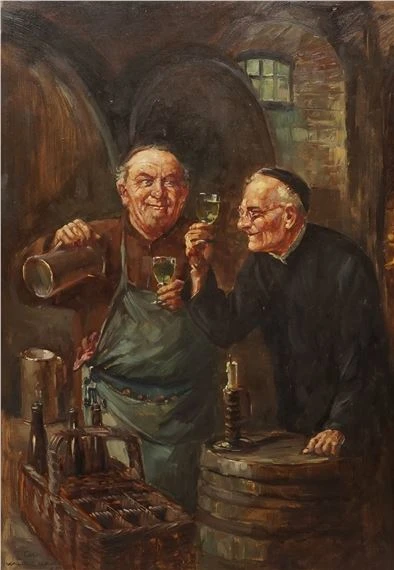
Hops Farming - Oil and Acid Readings
Table of Readings for Bloomfield Hops Oils
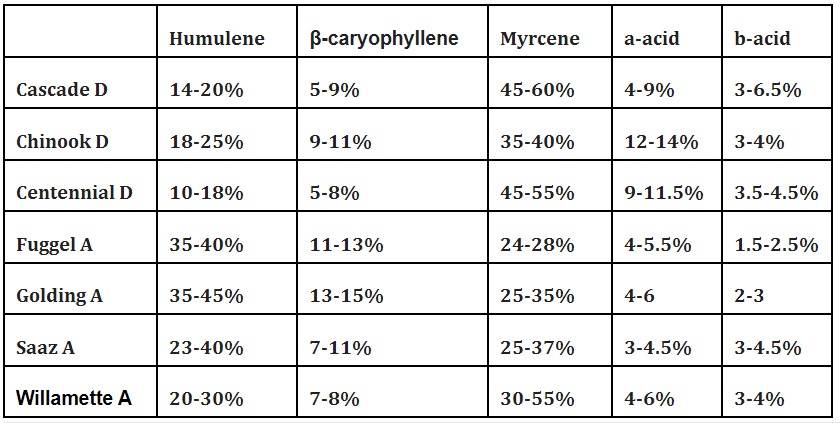
Pelletizing and Storing Hops
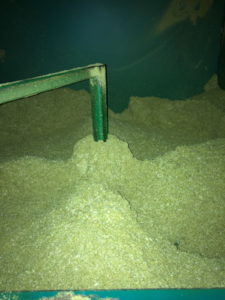
Hops Farming - Pelletizing Hops
Pelletizing is the process of gathering together (known as agglomeration) or compacting fine solid particles to form larger pellets. It is used in numerous industries because it is much easier to handle and store the pelletized product compared to the material in its raw form. Once the hops have been pelletized, they are stored in mylar bags that are flushed wth nitrogen to remove any oxygen and vacuum-sealed for later use. Hops can be stored for several years in this way and be fresh for use for brewing beer.
Bloomfield Hops Farming
Growing the Flavour, One Hop at a Time
25% Off or Buy 2 Get 1 Free on First Order!
*THE 3 C'S OF HOPS
*Bitter to Aroma Hops
*Assorted Sizes & Variety Packs!
The Three "c"s in Hops Farming
Hops Farming - The Three "C"s in Hops
Cascade, Centennial, and Columbus are three classic American Hops that are used to brew IPAs. They are also the most used dual-purpose hops varieties year in and year out. Many experts would add Chinook as a fourth hop for this group. These hops are also high in alpha acids and iso-alpa-acids.
Cascades are described as floral and citrus-like aromas, with a tinge of grapefruit. They are not high in alpha acids, but are high in cohumulone, which is the alpha acid that has the most bite.
Centennial is a dual-purpose hop that can be used for any part of the brewing process. It was bred as improvement to Cascade hops by raising the alpha acids levels and decreasing the level of cohumulone.
Columbus and Chinook hops are both high in cohumulone, which makes them quite bitter. Columbus are used primarily for bittering and have a distinct pungent aroma. Chinook are more versatile and has more piney/grapefruit scents. It is higher in alpha acids but lower in cohumulone
Hops Farming - Bitter Hops to Aoma Hops
Hops are divided into three primary categories:
Bittering hops – based on their high amount of acid that imparts the bitter flavor into the brewed beer.
Aroma hops– more distinct aroma and flavor and less acid. Many beer recipes have both kinds of hops, though others combine dual-purpose hops.
Dual-purpose hops are more balanced in the amount of acid and aroma. Since dual-purpose hops can be used for aroma and bittering, they are convenient to use for brewing batches of craft beer with a singe variety of hop. The 3(4) C’s are all dual-purpose hops that are used in many combintions.
Bitter Hops to ARoma Hops

Sizes and Variety Packs From BLOOMFIELD Hops
Hops Farming - Brew Hops Varieties
Bloomfield Hops Farms offers 8 different varieties of hops for brewing. The dual purpose are convenient for brewing with a single hop, though recipes tend to feature combining more than one variety. View our receipe recommendations for our brewing hops here. Their categories are as follows:
Aroma Hops – Fuggle, Golding, Saaz, Tettnang, Willamette;
Dual-purpose Hops – Cascade, Centennial, Chinook.